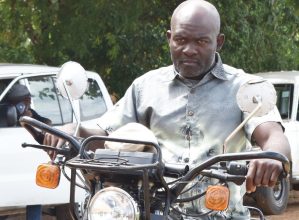Making vaccines work
Linda Edward, 23, from Sitima Village, Traditional Authority (T/A) Mulumbe, in Zomba District, refuses to gamble with her life.
One sunny Wednesday morning, she received Covid-19 booster vaccine at Namikango Health Centre in Zomba.

“Wednesday is a busy market day at Thondwe Trading Centre, but I branched off because it can wait. I want to protect my life because my children need me alive,” said the mother of two after receiving the booster, with three-month-old Rihanna on her lap.
Linda received the booster dose six months after being fully vaccinated with Johnson and Johnson.
“The booster strengthens my immunity as Covid-19 may resurface in a different form,” she says.
Muted crisis
Covid-19 is no longer a public health emergency of global concern, the World Health Organisation announced in May. The feat follows falling cases and rising vaccination figures worldwide.
However, health workers say vaccination remains essential as the deadly coronavirus disease persists.
Estere Mateyuwami, 46, of Sanjika Village in the rural locality under T/A Mulumbe got the first jab in 2021 during the world’s deadliest Covid-19 wave.
She was nursing a tuberculosis patient at Zomba Central Hospital where she saw firsthand the chilling effect of Covid-19, “as many patients died from breathing difficulties.
“Health workers said the Covid-19 vaccine could have reduced the number of deaths and critical patients, so I received the first dose the day my patient was discharged and the second three months later.”
Boosting cold chain
Estere received a booster shot at Namikango Health Centre together with Edward.
As they watched, health surveillance assistant Rhoda Banda retrieved a chilled vaccine bottle from a solar-powered refrigerator donated by Unicef with support from Japan. The cold chain support also included two coldboxes for carrying vaccines to surrounding communities.
A detector on the wall alerts health workers whether the vaccine refrigerator is working or faulty. The sensors, installed in at least 800 of the more than 1 500 health facilities nationwide, are remotely connected to the national control room in Lilongwe. This allows health authorities to make swift decisions so that no vaccine dose goes to waste.
The fridge, cold boxes and vaccine carriers keep vaccines potent during routine immunisation for children under five and emergency vaccination campaigns.
Amid piling outbreaks, community health workers have hit the road delivering life-saving vaccines against Covid-19, cholera and polio resurgence.
To increase the uptake, they go door-to-door to administer vaccines where people live, meet and work.
Zomba district chief preventive health officer Innocent Mvula says the cold chain facilities have become handy for improved immunisation services, particularly during outreach clinics and periodic campaigns.
He explains: “Vaccines perish when exposed to high temperatures, so the cold chain supported by the Japanese Government and Unicef assists us in maintaining the quality of vaccines.
“The solar-powered refrigerator is centrally positioned in the Thondwe Cluster, where it safely stores vaccines for Namikango and four surrounding health facilities, especially during power outages.”
HSA Hannet Singo says delivering vaccines that work boosts public confidence in immunisations.
“Keeping vaccines chilled and potent is vital to tackle myths, misinformation and fatigue as we have to deliver multiple vaccines simultaneously,” he says.
Instant reporting
After administering polio and Covid, community health workers such as Singo and his fellow HSAs enter the vital figures via a short-message facility on their phones. The mobile phone instantly transmits the data from the field to a national server, making it accessible for real-time monitoring and decision-making beyond the facility.
Singo explains how the reporting tool called Rapid Pro works: “When I send ‘covid’ or ‘polio’ to the designated number, the system recognises me and generates questions that help me enter real-time data such as the number of people vaccinated and their sex. It is fast and doesn’t accept mistakes. If the figures cannot add up, it prompts for corrections.”
Japan provided phones to 11 500 HSAs nationwide.
They say Rapid Pro is more user-friendly than pen and paper.
“Even if the paper-based report delays, we can tell the number of people vaccinated and whether we are on or off track,” says Zomba district immunisation coordinator Kampapa. “It helps us rapidly deploy more vaccinators or adjust strategies where access is poor.”
Recently, Japanese Ambassador Youichi Oya toured Namikango Health Centre, which serves a population of nearly 13 000.
“Rapid Pro is a useful and advanced tool. In Japan, we still use pen and paper to record and report vaccination data,” he said. “I am impressed that all the facilities supplied are in good shape and continue to protect lives, so my message to the hard-working health workers is: Take good care of them and repair them periodically.”
Unicef country representative Shadrack Omol says Japan is a trusted partner in supporting the Ministry of Health vaccination inroads, including strengthening the cold chain, monitoring and evaluation.
“It is crucial that people receive vaccines that work and policymakers get information real-time to monitor progress and make life-saving decisions,” he says. “Covid is no longer a global public health emergency, but people still need to protect themselves from the virus, which is still in our midst.”





